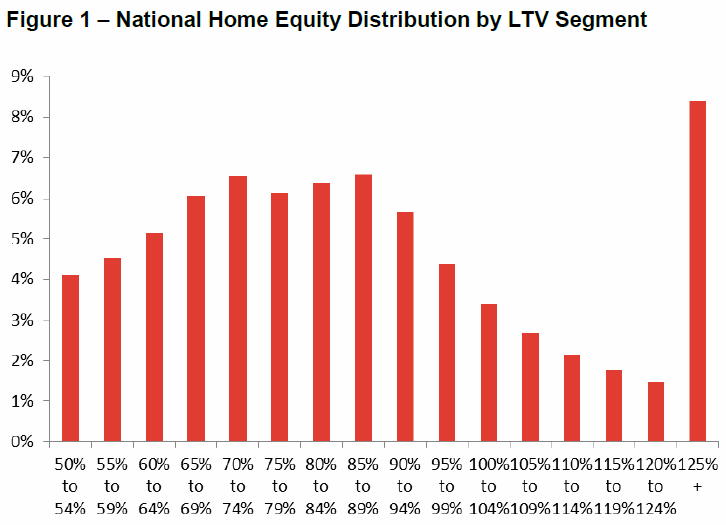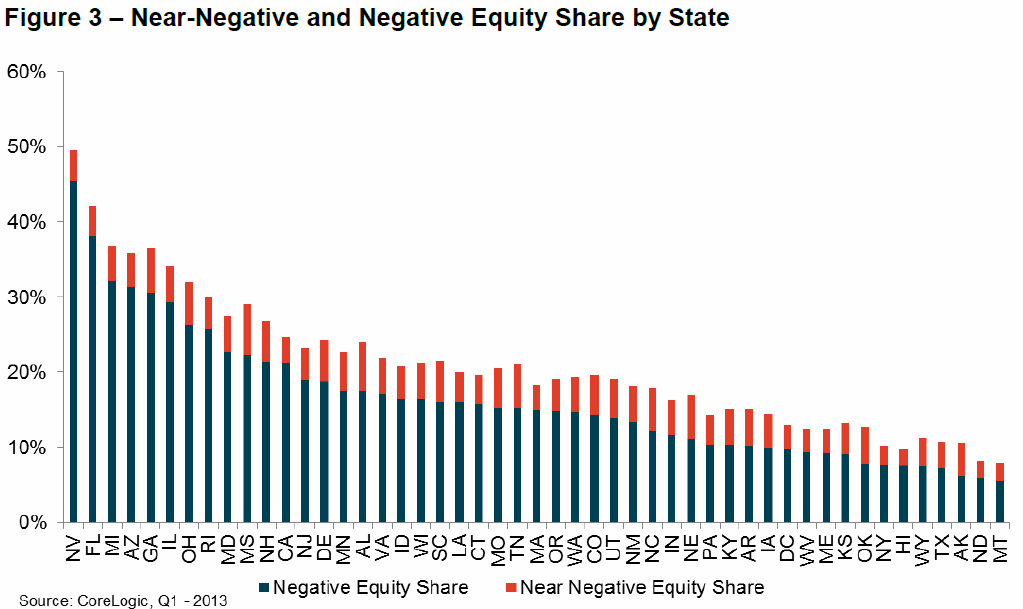Blog

Fewer than 1 in 5 Homes Now Underwater, But Buoyancy Varies
<pOver three-quartersrnof a million homeowners emerged from being underwater on theirrnmortgages during the first quarter of 2013 and 39 million households</bnow have positive equity in their homes. However, millions of thosernhomeowners are only narrowly in that position. CoreLogic reportedrnWednesday that 850,000 more homes returned to a state of positivernequity between January and March.</p<pNegative equity,rnoften referred to as "underwater" or "upside down," meansrnthat borrowers owe more on their mortgages than their homes arernworth. Negative equity can occur because of a decline in value, anrnincrease in mortgage debt or a combination of both. </p<pAt the end of thernquarter 9.7 million households or 19.8 percent of all properties withrna mortgage remained underwater compared to 10.5 million homes or 21.7rnpercent of mortgaged properties at the end of the fourth quarter ofrn2012. The aggregate value of underwater property decreased morernthan $50 billion to $580 billion quarter-to-quarter. CoreLogic saidrnthis decrease was largely driven by rising home prices.</p<pBut many of thernhomes in positive territory remain on shaky ground. Of those 39rnmillion properties, 11.2 million have less than 20 percent equity,rnwhat CoreLogic calls “under-equitied” and may have a morerndifficult time refinancing. Another 2.1 million had less than 5rnpercent equity, referred to as near-negative equity. Thesernproperties are at risk of returning to negative status should homernprices fall. Under-equitied mortgages account for 23 percent ofrnmortgaged properties. The average amount of equity for allrnproperties with a mortgage is 32.8 percent.</p
 </p
</p
Of the $580 billionrnin negative equity, homes with only first liens accounted for $290rnbillion or one-half the aggregate negative balance. The remainingrnhalf were properties with home equity loans. Among the 6.0 millionrnupside-down homeowners with only first mortgage liens the averagernmortgage balance was $211,000 and they were underwater by an averagernof $48,000. The 3.7 million borrowers with both first and secondrnmortgages had average total loan balances of $294,000 and werernnegative by an average of $79,000. </p
CoreLogicrnsaid that higher end properties were more likely to have positivernequity than the low end. Forrnexample, 88 percent of homes valued at greater than $200,000 havernequity compared with 73 percent of homes valued at less thanrn$200,000.</p<p"The impressivernhome price gains of 2012 and the beginning of 2013 have had a bigrnimpact on the distribution of residential home equity,” said Dr.rnMark Fleming, chief economist for CoreLogic. “During the past year,rn1.7 million borrowers have regained positive equity. We expect thernpent-up supply that falling negative equity releases will moderaternprice gains in many of the fast-appreciating markets this spring.”</p<pThe highestrnpercentage of negative equity properties were in Nevada at 45.4rnpercent. Florida was second at 38.1 percent followed by Michigan (32rnpercent), Arizona (31.3 percent) and Georgia (30.5 percent.) Theserntop five states combined account for 32.8 percent of negative equityrnin the U.S.</p

All Content Copyright © 2003 – 2009 Brown House Media, Inc. All Rights Reserved.nReproduction in any form without permission of MortgageNewsDaily.com is prohibited.
Latest Articles
By John Gittelsohn August 24, 2020, 4:00 AM PDT Some of the largest real estate investors are walking away from Read More...
Late-Stage Delinquencies are SurgingAug 21 2020, 11:59AM Like the report from Black Knight earlier today, the second quarter National Delinquency Survey from the Read More...
Published by the Federal Reserve Bank of San FranciscoIt was recently published by the Federal Reserve Bank of San Francisco, which is about as official as you can Read More...

Comments
Leave a Comment